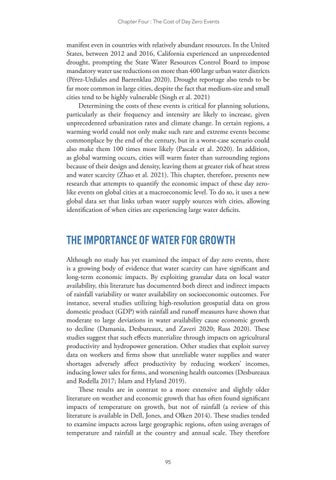Chapter Four : The Cost of Day Zero Events
manifest even in countries with relatively abundant resources. In the United States, between 2012 and 2016, California experienced an unprecedented drought, prompting the State Water Resources Control Board to impose mandatory water use reductions on more than 400 large urban water districts (Pérez-Urdiales and Baerenklau 2020). Drought reportage also tends to be far more common in large cities, despite the fact that medium-size and small cities tend to be highly vulnerable (Singh et al. 2021) Determining the costs of these events is critical for planning solutions, particularly as their frequency and intensity are likely to increase, given unprecedented urbanization rates and climate change. In certain regions, a warming world could not only make such rare and extreme events become commonplace by the end of the century, but in a worst-case scenario could also make them 100 times more likely (Pascale et al. 2020). In addition, as global warming occurs, cities will warm faster than surrounding regions because of their design and density, leaving them at greater risk of heat stress and water scarcity (Zhao et al. 2021). This chapter, therefore, presents new research that attempts to quantify the economic impact of these day zerolike events on global cities at a macroeconomic level. To do so, it uses a new global data set that links urban water supply sources with cities, allowing identification of when cities are experiencing large water deficits.
THE IMPORTANCE OF WATER FOR GROWTH Although no study has yet examined the impact of day zero events, there is a growing body of evidence that water scarcity can have significant and long-term economic impacts. By exploiting granular data on local water availability, this literature has documented both direct and indirect impacts of rainfall variability or water availability on socioeconomic outcomes. For instance, several studies utilizing high-resolution geospatial data on gross domestic product (GDP) with rainfall and runoff measures have shown that moderate to large deviations in water availability cause economic growth to decline (Damania, Desbureaux, and Zaveri 2020; Russ 2020). These studies suggest that such effects materialize through impacts on agricultural productivity and hydropower generation. Other studies that exploit survey data on workers and firms show that unreliable water supplies and water shortages adversely affect productivity by reducing workers’ incomes, inducing lower sales for firms, and worsening health outcomes (Desbureaux and Rodella 2017; Islam and Hyland 2019). These results are in contrast to a more extensive and slightly older literature on weather and economic growth that has often found significant impacts of temperature on growth, but not of rainfall (a review of this literature is available in Dell, Jones, and Olken 2014). These studies tended to examine impacts across large geographic regions, often using averages of temperature and rainfall at the country and annual scale. They therefore
95



